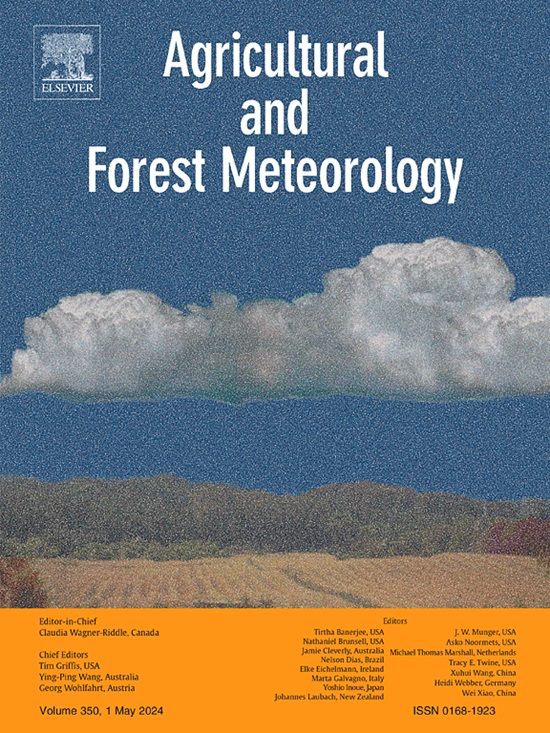The TreeChill model: A new framework for predicting the impact of erratic winter weather on trees
IF 5.7
1区 农林科学
Q1 AGRONOMY
引用次数: 0
Abstract
Perennial plants rely on exposure to low winter temperatures to break dormancy, aligning reproductive timing with local weather conditions. Current chill accumulation models quantify this exposure using only air temperature as input, leading to reduced accuracy as climate becomes more variable and unpredictable. This study introduces a novel framework that replaces air temperature with tree temperature as a continuous functional parameter to improve the reliability of chill accumulation calculations. Over three winters, we measured tree temperature and collected weather data in sweet cherry orchards in distinct climate areas. Tree temperature exceeded air temperature, particularly on sunny days, leading to a 15 % reduction in chill accumulation. We developed the TreeChill model, which predicts tree temperature using publicly available weather data with high precision. The model has a coefficient of determination of 0.930 and a standard deviation of residuals of 2.02 °C. The difference in chill accumulation calculated using predicted versus measured tree temperature was only 0.4 chill portions. Tree temperature provided more accurate insights into dormancy-related processes than air temperature. Variations in bloom progression within sweet cherry tree canopies corresponded to differences in tree temperature, and bloom timing was precipitated by prolonged winter chill exposure at the branch level, followed by localized short-term heat exposure. This study integrates macro- and micro-climatic data and plant physiological information and can be used in different climate-related prediction models to enhance their precision. The model will make tree temperature readily available to researchers and stakeholders, facilitating the development of climate change mitigation strategies in agricultural, natural and urban systems.


TreeChill模型:一个预测不稳定冬季天气对树木影响的新框架
多年生植物依靠暴露在冬季的低温中来打破休眠,使繁殖时间与当地的天气条件保持一致。目前的冷积累模型仅使用空气温度作为输入来量化这种暴露,导致准确性降低,因为气候变得更加多变和不可预测。为了提高冷积累计算的可靠性,本研究引入了一个新的框架,用树木温度代替空气温度作为连续函数参数。在三个冬天里,我们测量了不同气候区的甜樱桃园的树温并收集了天气数据。树木温度超过气温,特别是在晴天,导致冷积累减少15%。我们开发了TreeChill模型,该模型使用公开可用的天气数据以高精度预测树木温度。模型的决定系数为0.930,残差标准差为2.02°C。利用预测树温与实测树温计算的冷积累量差异仅为0.4个冷量。与气温相比,树木的温度可以更准确地了解与休眠相关的过程。甜樱桃树冠层内开花进程的变化与树温的差异相对应,开花时间由枝条水平上的长时间冬季低温暴露和局部短期热暴露促成。该研究整合了宏观和微观气候数据以及植物生理信息,可用于不同的气候相关预测模型,以提高预测精度。该模型将使研究人员和利益相关者随时可以获得树木温度,促进农业、自然和城市系统中气候变化缓解战略的发展。
本文章由计算机程序翻译,如有差异,请以英文原文为准。
求助全文
约1分钟内获得全文
求助全文
来源期刊
CiteScore
10.30
自引率
9.70%
发文量
415
审稿时长
69 days
期刊介绍:
Agricultural and Forest Meteorology is an international journal for the publication of original articles and reviews on the inter-relationship between meteorology, agriculture, forestry, and natural ecosystems. Emphasis is on basic and applied scientific research relevant to practical problems in the field of plant and soil sciences, ecology and biogeochemistry as affected by weather as well as climate variability and change. Theoretical models should be tested against experimental data. Articles must appeal to an international audience. Special issues devoted to single topics are also published.
Typical topics include canopy micrometeorology (e.g. canopy radiation transfer, turbulence near the ground, evapotranspiration, energy balance, fluxes of trace gases), micrometeorological instrumentation (e.g., sensors for trace gases, flux measurement instruments, radiation measurement techniques), aerobiology (e.g. the dispersion of pollen, spores, insects and pesticides), biometeorology (e.g. the effect of weather and climate on plant distribution, crop yield, water-use efficiency, and plant phenology), forest-fire/weather interactions, and feedbacks from vegetation to weather and the climate system.

 求助内容:
求助内容: 应助结果提醒方式:
应助结果提醒方式:


